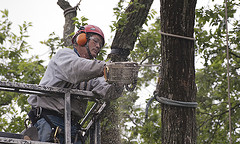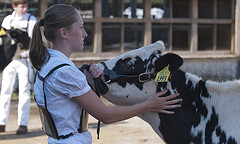Researchers seek elusive answers to stink-bug infestations
Wednesday, September 29, 2010
University Park, Pa. -- With apologies to William Shakespeare, something is -- or, more accurately, smells -- rotten in the state of Pennsylvania, and in other states across the country.
In many homes and orchards, this odor is coming from the brown marmorated stink bug, the latest in what seems to be a steady stream of exotic, invasive insects that have found their way into the United States in recent years. And as with many of its fellow interlopers -- such as the Asian longhorned beetle and the emerald ash borer -- experts haven't yet identified any good solutions for managing or eradicating the pest.
Brown marmorated stink bug adults are about three-quarters of an inch long and are shades of brown on both the upper and lower body surfaces. They are almost as wide as they are long, and their "shield" shape is typical of other stink bugs. The name "stink bug" refers to the scent glands that emit a distinctive odor when the insect is disturbed or crushed. They are not known to bite people or to spread diseases.
This variety of stink bug first was found in the United States in Lehigh County in 1998, and it since has become a perennial nuisance to homeowners as the bugs seek winter shelter -- sometimes by the thousands -- in and around houses and other structures. But this year, the pest has caused a greater stir, according to Steven Jacobs, extension entomologist in Penn State's College of Agricultural Sciences.
"First, this year's warm spring and early summer allowed the stink bug to reproduce at a faster pace," Jacobs explained. "Normally, you'd see one generation of stink bugs per growing season, but this year, we've had three generations, leading to higher and faster-spreading populations.
"But in addition to being a nuisance, it has become a serious agricultural pest, just as it is in its native range of China, Japan, Korea and Taiwan," he said. "In 2010, stink bugs have caused extensive damage in some Pennsylvania apple and peach orchards and have been found feeding on blackberry, sweet corn, field corn and soybeans. In neighboring states, they also have damaged tomato, lima bean and green pepper crops. In all, they can attack an estimated 300 host-plant species."
Greg Krawczyk, tree fruit extension entomologist at Penn State's Fruit Research and Extension Center in Biglerville, noted that because this insect is native to Asia, it has few if any natural enemies in the United States to help control its populations. And pesticides are not a particularly good option for growers, some of whom have lost 40 to 50 percent of their crops to stink bugs.
"If control is needed to protect fruit crops, our preliminary data suggest that broad-spectrum, contact insecticides should work best," Krawczyk said. "But these compounds may not provide adequate control because they don't show residual activity, meaning that bugs migrating into an orchard after spraying can start a new population very quickly."
These broad-spectrum pesticides also will kill the beneficial insects growers rely on as part of integrated pest management, or IPM, programs, he added. "That would upset the balance in the orchard ecosystem -- allowing other pests to become more of a problem -- and could reverse much of the progress we've made in IPM, which has helped Pennsylvania growers to reduce pesticide use by as much as 75 percent in recent decades."
Stink bugs do their damage by inserting mouthparts under the skin of the fruit, injecting saliva and sucking out the juices. While not harmful to people, this feeding leaves exterior dimpling and dried, cork-like areas in the fruit, making it unmarketable at the retail level.
"This damaged fruit is downgraded and sold for processing or juice for maybe $7 to $10 per bushel, compared to anywhere from $20 to $60 per bushel on the fresh-fruit market," said Krawczyk. "One grower whose crop has been damaged by stink bugs told me that if he has one or two more years like this one, he'll be out of business."
Krawczyk and scientists at other universities and the U.S. Department of Agriculture are studying the brown marmorated stink bug, with an eye toward developing monitoring systems and management tactics. But he said because this is a new pest in this country, more resources are needed, and it may take a few years before the problem can be addressed effectively.
Similarly, homeowners who are fighting an invasion of stink bugs have few options, conceded Jacobs. "Mechanical exclusion is the best method to keep stink bugs from entering homes and buildings," he said. "Caulk cracks around windows, doors, siding, utility pipes, behind chimneys and underneath the wood fascia and other openings. Damaged screens on doors and windows should be repaired or replaced.
"If bugs already are inside the house, try to identify their entry path and caulk or otherwise seal cracks under or behind baseboards, around window and door trim, and around exhaust fans or ceiling lights," he advised. "You can use a vacuum cleaner to remove live or dead stink bugs, but be aware that the vacuum may take on the smell of the insects for a period of time."
Jacobs said most pesticides will not stop a home infestation, and he does not recommend that homeowners apply insecticides to kill stink bugs indoors.
A Penn State fact sheet about the brown marmorated stink bug is available online at http://ento.psu.edu/extension/factsheets/brown-marmorated-stink-bug.
Contact
-
- Chuck Gill
- 814-863-2713

























